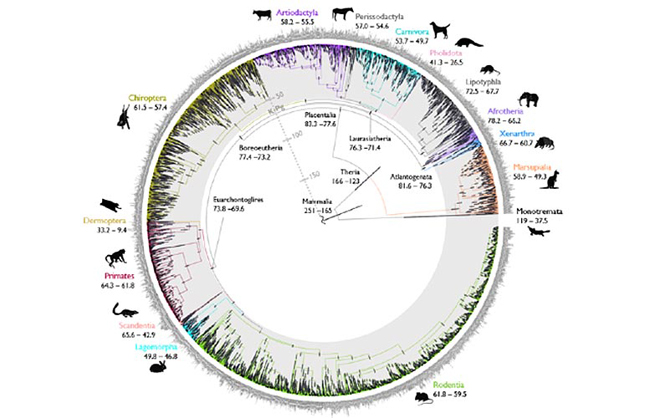Dating the Mammal Tree of Life
Recently published research has answered an important question regarding the timing of the evolutionary origins of modern types of placental mammals such as the Carnivora, the rodents and the primates. Once the non-avian dinosaurs vanished some 66 million years ago, placental mammals rapidly evolved and diversified to fill many of the niches in ecosystems vacated by the extinct members of the Dinosauria.
The research team who included scientists from Queen Mary University of London, Cambridge University, University College London, the University of Bristol and Imperial College London used a new and fast Bayesian statistical approach to plot the timeline of mammal evolution. The data generated confirms the hypothesis that although the first placental mammals evolved in the Mesozoic, it was only after the KPg extinction event that marked the end of this Era and the beginning of the Cenozoic, some 66 million years ago, that the ancestors of today’s modern placental mammal groups evolved.

Analysing the Mammalian Genomic Dataset
Writing in the academic journal “Nature”, the scientists used a novel Bayesian statistical method to analyse an enormous mammal genomic dataset, in a bid to plot more precisely the timeline of the evolution of modern mammals. They conclude that the ancestors of these modern groups postdate the KPg extinction event.
The Bayesian analysis had to be robust, not only to handle the genetic data from almost 5,000 mammal species and 72 complete genomes but also to accommodate and account for uncertainties within the huge amount of data being processed.

Tackling a Contentious Topic in Evolutionary Biology
Commentating on the significance of this study, one of the co-authors of the paper, Professor Philip Donoghue (Bristol University) stated:
“The timeline of mammal evolution is perhaps one of the most contentious topics in evolutionary biology. Early studies provided origination estimates for modern groups deep in the Cretaceous, in the dinosaur era. The past two decades had seen studies moving back and forth between post- and pre-KPg diversification scenarios. Our precise timeline settles the issue.”
The statistical method developed for this study can be used to help resolve other controversial areas of research that require the detailed analysis of huge amounts of data. The scientists are confident that this technique can be applied to even grander projects such as the Earth BioGenome project which aims to plot a reliable evolutionary timescale for the development of life on Earth.
Everything Dinosaur acknowledges the assistance of a media release from the University of Bristol in the compilation of this article.
The scientific paper: “A Species-Level Timeline of Mammal Evolution Integrating Phylogenomic Data” by Sandra Álvarez-Carretero, Asif U. Tamuri, Matteo Battini, Fabrícia F. Nascimento, Emily Carlisle, Robert J. Asher, Ziheng Yang, Philip C. J. Donoghue and Mario dos Reis published in the journal Nature.
Visit Everything Dinosaur’s website: Everything Dinosaur.

